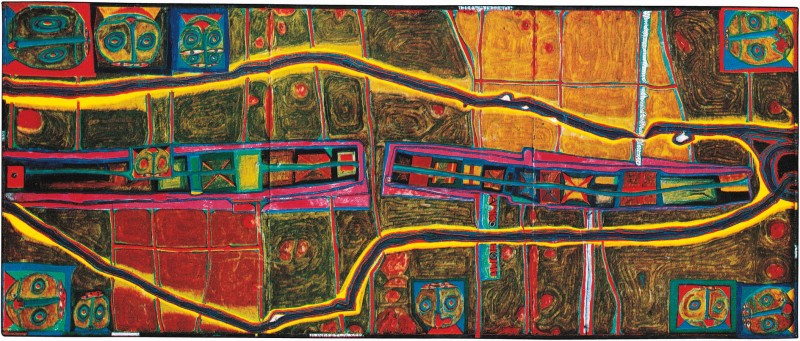175
LE PRESQUE CERCLE
DER FAST EIN KREIS - DER BEINAHE KREIS
The Almost Circle
1953
Painted in St. Mandé/Seine, Castle Dumage, October 1953
590 mm x 1400 mm
Oil on three joined box covers made of wood fibre, primed with chalk, zinc white and fisch glue, surrounded by a "baguette électrique"
KunstHausWien, Vienna (loan by Fondation Gandur pour l'Art)
- Studio Paul Facchetti, Paris, 1954
- Galerie St. Stephan, Vienna, 1957
- 31st Venice Biennial, 1962
- Museum des 20. Jahrhunderts, Vienna, 1965
- Galerie Paul Facchetti, Paris, 1974
- Centre de la Vieille Charité, Marseille, 2012
- Le Musée en Herbe, Paris, 2013/14
- Staatliches Kunstmuseum, Baden-Baden, 1959
- W. Schmied, Hundertwasser, Salzburg, 1974 pl. 38 (c), p. 313
- Das Hundertwasser Haus, Vienna 1985, p. 40 (c)
- Hundertwasser Architektur, Cologne, 1996, p. 27 (c)
- P. Restany, Die Macht der Kunst, Hundertwasser - Der Maler-König mit den fünf Häuten, Cologne, 1998, p. 60 (c)
- W. Schmied, Hundertwasser 1928-2000, Catalogue Raisonné, Cologne, 2000, Vol. I, pp. 170 (c), 176
- A. C. Fürst, Hundertwasser 1928-2000, Catalogue Raisonné, Cologne, 2002, Vol. II, pp. 256-258 (and c)
- G. Illetschko, Planet Hundertwasser, Munich, 2012, p. 27 (c)
- Leaflet: Galerie St. Stephan, Vienna, 1957, cat. 41
- XXXI. Biennale di Venezia, Austria, 1962, cat. 7
- Kestner-Gesellschaft, Hanover, 1964, p. 124
- Museum des 20. Jahrhunderts, Vienna, 1965, cat. 34
- Postcard-Catalogue, Galerie Paul Facchetti, Paris, 1974, cat. 6 (c)
- Musée d'Art Moderne de la Ville de Paris, 1975, p. 130 (c)
- Musée de l'Etat, Luxemburg, 1975, p. 430 (c)
- Musée Cantini, Marseille, 1975, p. 430 (c)
- A.S.U. Hall, Cairo, 1975, p. 430 (c)
- The Tel Aviv Museum, 1976, p. 429 (c)
- National Gallery of Iceland, Reykjavik, 1976, p. 369 (c)
- Statens Museum for Kunst, Copenhagen, 1976, p. 130 (c)
- Musée Dynamique, Dakar, 1976, p. 130 (c)
- Seibu Museum of Modern Art, Tokyo, 1977, p. 429 (c)
- South African National Gallery, Cape Town / Pretoria Art Museum, 1977, p. 429 (c)
- Museu de Arte Moderna, Rio de Janeiro / Museu de Arte, Sao Paulo / Palácio Itamaraty, Brasilia, 1977, p. 429 (c)
- Museo de Bellas Artes, Caracas, 1977, p. 429 (c)
- Museo de Arte Moderno, Mexico City, 1978, p. 429 (c)
- Musée des Beaux-Arts, Montreal, 1978, p. 130 (c)
- Royal Ontario Museum, Toronto, 1978, p. 429 (c)
- Palais des Beaux-Arts, Brussels, 1978, p. 130 (c)
- Palazzo Barberini, Rome, 1980, p. 429 (c)
- Sonja Henies og Niels Onstads Stiftelser Kunstsentret, Høvikodden, 1980, p. 429 (c)
- Helsingin kaupungin taidemuseo, Helsinki, 1981, p. 429 (c)
- Barbican Art Gallery, London, 1983, p. 429 (c)
- Centre de la Vieille Charité, Marseille, 2012, p. 71 (c)
- F. Villemur/ B. Pietrzak, Paul Facchetti: Le Studio, Arles, 2004, p. 159 (c)
- St. Scoffham (ed.), Teaching Geography Creatively, Abingdon, 2012, pl. B (c)
- M. Mackintosh/ G. Kent, The Everyday Guide to Primary Geography: Art, Sheffield, 2014, p. 18-19 (and c)
- Westermanns Monatshefte, no. 9, Sept. 1974, Braunschweig p. 27 (c)
- Connaissance des arts, no. 275, Jan. 1975, Paris, p. 67 (c)
- Lebenskunst, no. 2, 2000, Cologne, p. 42 (c)
- Hundertwasser 2004 Calendar, Taschen, Cologne

Hundertwasser's comment on the work
Even if man is forced to walk through streets straight as a ruler, his personal, individual trail is never straight, but subject to his momentary impulses.
(from: Hundertwasser Architecture, Cologne, 1997, p. 27)
I have a bicycle. Paris is big. I want to say that the lines that I draw with my bicycle through this great city are extraordinary. The lines are just as wonderful as all the other lines I cross traced by all the other people. I ride around people and obstacles. I am happy at last to be in harmony and in contact with the others as a painter. These lines, for which I need many hours and which form an enormous circle by the time I come back and which make me tired, are more beautiful, more genuine and more justified than those I could draw on paper. And I dare say that the lines I trace with my feet on the pavement walking to the museum are more important than the lines I will find there hanging on the walls inside. And it pleases me enormously to see that the line I trace is never straight, never confused, but has a reason to be like this in every tiny part. Beware of the straight line and the drunken line. But above all beware of the T-squared straight line. The straight line leads to the downfall of humanity. La ligne droite conduit à la perte de l'humanité. (Text for the catalogue of the first exhibition at Studio Facchetti, Rue de Lille, Paris; written in Paris, December, 1953, from: Cat. Museum Ludwig, Cologne, 1980, p. 111)
The text in Facchetti's catalogue was written for this picture. The circuitous route a person takes can be plainly seen. In the text I take a stand against the (T-squared) straight line for the first time. (from: Hundertwasser 1928-2000, Catalogue Raisonné, Vol. 2, Taschen, Cologne, 2002, p. 256)